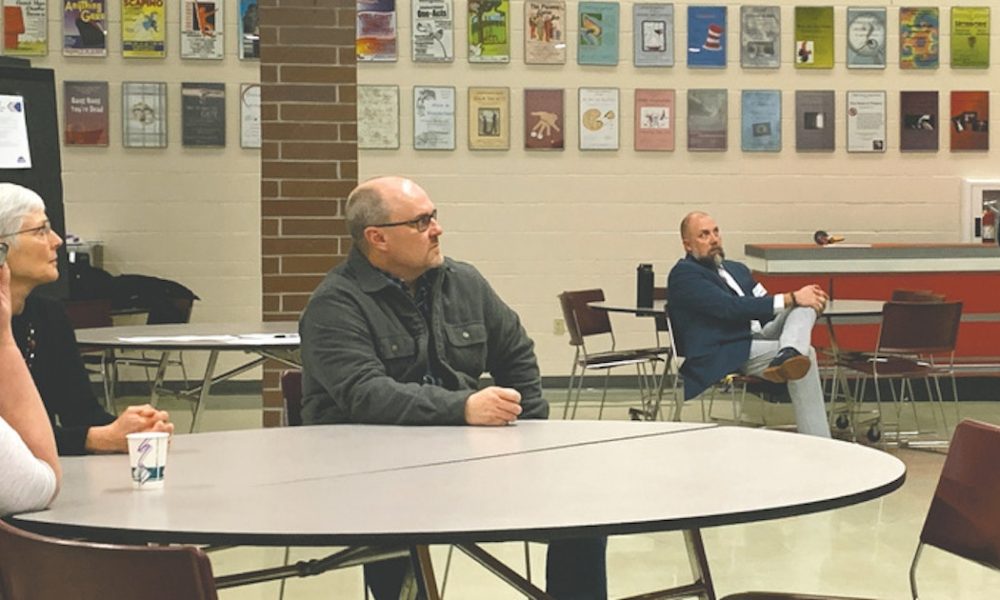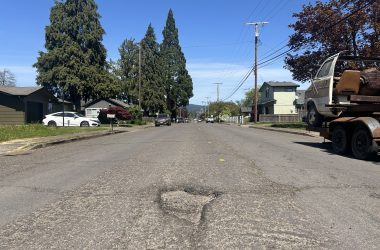 Cottage Grove High School Success Coordinator Jeremy Smith explains the Student Success Act during a community input session on Dec. 10. The additional funding from the SSA is expected to generate an additional $2.3 million per year beyond regular state funding for the district. Aliya Hall/The Chronicle
Cottage Grove High School Success Coordinator Jeremy Smith explains the Student Success Act during a community input session on Dec. 10. The additional funding from the SSA is expected to generate an additional $2.3 million per year beyond regular state funding for the district. Aliya Hall/The Chronicle
COTTAGE GROVE – South Lane School District is in the process of seeking community input on how to invest the new $2.3 million funds from the Student Success Act in their district.
The district held a community input session to gather votes and feedback about where the money should go to help solve six of the big challenges the district faces before applying for the SSA grant money. The first session was held at Cottage Grove High School on Dec. 10.
”Maybe for the first time in a long time, we don’t feel spread too thin in a particular areas,” High School Success Coordinator Jeremy Smith said. ”We will always have educators who work beyond their hours at 110% while at school, but this will hopeful provide us with extra support for those who are struggling.”
The SSA’s primary goal is to improve outcomes for historically underserved or underachieving students. Passed by the legislature, the SSA will provide $1 billion per year beyond the regular Early Learning and K-12 State School Fund to support early learning, local school districts and a number of statewide educational initiatives starting in the 2019-20 school year.
”It’s a significant amount of money to do solid things in our district,” Smith said.
The input session was an opportunity for Cottage Grove residents to look at the ideas that the district has already come up with to solve some of the inequities that they face in the district and then vote on the solutions that they thought would make the most impact. The district reviewed data to identify areas of need in regards to reading and math scores, attendance and graduation rates, behavioral referrals and mental health surveys.
The data was analyzed and broken down by staff members into grade levels and disaggregated by students of color, students who are economically disadvantaged or who qualify for special education (SPED) services. From that, staff created six summary statements about groups that struggled the most and across which grade levels.
Statement one focused on the Latinx community. Compared to their peers in South Lane, Latinx and English language learners score lower on statewide reading and math assessments, graduate at lower rates and experience poorer high school attendance. This group, however, receives fewer behavior referrals and through eight grade show better than average attendance rates.
Statement two said that when compared to their peers, students of color score lower on statewide reading and math assessments, receive a disproportionate amount of behavior referrals and suspensions and attend less regularly, except for Black middle school students and middle school indigenous peoples’ reading scores.
Statement three focused on special education, saying students who qualify for SPED score lower on statewide reading and math assessments, receive a disproportionate amount of behavior referrals, attend less regularly in elementary and high school and have lower graduation rates.
Statement four focused on behavior, noting that male students receive significantly more behavioral referrals than female students.
Statement five said that when compared to peers, students who are homeless or economically disadvantaged score lower on statewide reading and math assessments and receive a disproportionate amount of behavior referrals. Across the board, the homeless portion of this group experience more academic difficulties than those in the economically disadvantaged group.
Statement six: socio-emotional and mental health, stating that eight graders experience more bullying, report higher mental health needs and suicide rates. Compared to the State, eighth and 11th grade students experience more bullying for LGBTQ+ issues and 11th graders experience a higher rate of substance abuse and sexual activity. Students also report more hunger due to lack of money.
One attendee asked if anyone was surprised that males were earning more referrals than females, and Smith said that in parsing through the data, there was ”a lot that isn’t a surprise, unfortunately.”
Staff then came up with over 30 ideas to meet the required criteria, and found that some services would help across multiple groups. Some of those include increased counseling services, increased staffing to work with specific populations, expand services at the Family Resource Center, focus on a Response to Intervention approach, have professional development seminars about equity and socio-emotional care, and after school and summer school support.
One idea was given and supported by students to have a high school language arts class just for Latinx students to help with the language barrier.
In January, there will be a staff stakeholder input on the 6th, as well as specific stakeholder groups that have dates yet to be decided.
”I hope that we give everyone an opportunity to share their voice,” Smith said. ”There are different ways we could address these issues and we want to come up with ones that’s supported by stakeholders but is also the most effective.”








